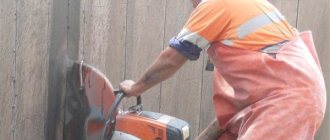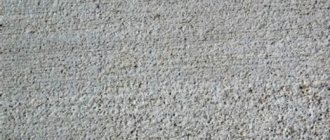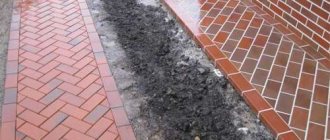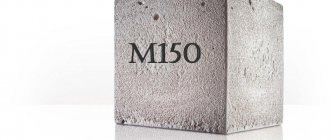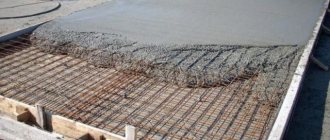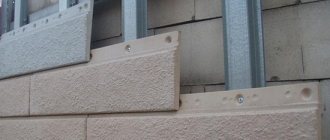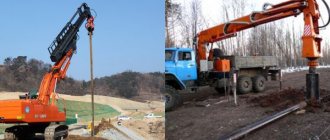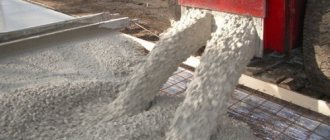When working with concrete, it is extremely important to consider the influence of ambient temperature on its hardening rate and strength. Ignoring this point can lead to a decrease in the quality of the material, which in some cases is simply unacceptable. Therefore, next we will consider what is the optimal temperature for concrete hardening, and what to do if the ambient temperature is significantly lower than this indicator.
Screeding in the cold season
General information
So, the best temperature for hardening concrete is considered to be about + 20 degrees Celsius. However, it is not always possible to withstand such conditions. There are times when it is necessary to perform concreting in the cold season.
For example, the need for winter work may arise in the following cases:
- Concreting on crumbling soils, which is difficult to do in the warm season.
- Winter discounts on cement. Sometimes the price of the material can be really very low, but at the same time, it makes no sense to store it until warming occurs, since the quality of the cement will decrease. In such a situation, the best option would be to carry out work in low temperature conditions.
- For private construction. It is often easier to get vacation in winter than in summer.
Note! In winter, it is more expensive to dig trenches, and it is necessary to provide a place for heating people. Therefore, it is not always profitable to engage in construction.
Pouring the foundation in winter
Sodium and calcium chloride in concrete
Antifreeze additive in concrete sodium chloride.
Sodium chloride or ordinary construction salt has many advantages, due to which the popularity of this composition increases. Used in construction as an anti-frost component during sub-zero temperatures. Allows you to reduce the crystallization temperature of water.
Calcium chloride is used as an accelerator for the hardening of concrete mortar, as well as to increase its strength and resistance to variable weather conditions. By accelerating the setting process of concrete, the time for installation of cement-based structures is reduced. The use of an anti-frost additive in concrete allows construction to continue during the cold season.
Return to contents
Features of pouring concrete at low temperatures
First of all, you need to figure out what temperature should be considered low when working with concrete. Among construction workers, the weather is considered cold if the average daily temperature drops below + 4 degrees Celsius. In this case, to successfully carry out this construction operation with your own hands, it is necessary to take special precautions that will protect the solution from the negative effects of cold.
The fact is that concrete hardens at low temperatures in a special way. The speed of this process and the quality of the final result largely depends on the temperature of the water in the composition.
The higher it is, the faster the solidification occurs. Its optimal value is 7-15 degrees.
However, low ambient temperature in any case has a critical effect on the rate of cement hydration. As a result, strength gain and hardening occurs much more slowly.
Insulation of a freshly poured foundation
To calculate how much concrete hardens at sub-zero temperatures, you need to take into account that a drop of 10 degrees reduces the hardening rate by half. Such calculations are important when planning construction work and removing formwork.
Note! If the temperature drops below -4 degrees Celsius, the solution will simply freeze, and in this case, the hardening process will stop altogether, and the concrete will lose up to 50 percent of its strength.
However, there are also positive aspects of pouring at low temperatures - with the correct organization of the process, there is a chance to get a better result, since a lower initial temperature ultimately gives greater strength. The only thing you need to remember at what temperature the concrete solution hardens, i.e. make sure that it does not fall below -4 degrees.
Additive to increase the rate of hardening
At what temperature can a foundation be poured: a step-by-step process on how to pour a foundation in winter
The reliability and durability of the entire structure directly depends on the strength of the foundation. When planning such a “zero” cycle of construction work, it is necessary to take into account many factors. Particularly important is the information at what temperature the foundation can be poured.
At what temperature can the foundation be poured?
If you do not take into account the weather conditions during the process of pouring the foundation, the quality and brand of the solution, the use of additives that can reduce the temperature crystallization of water, measures to maintain the necessary conditions for the maturation of concrete, then the work may be done in vain, and the constructed foundation of the building will begin to crumble immediately after hardening.
Some owners of suburban areas are in a hurry to build permanent structures on their newfound territory, not paying attention to the time of year. In some, rather rare cases, this may be justified; however, there are many difficulties with this approach, and they begin already at the stage of preparatory work.
The content of the article
1 Preparation for pouring the foundation2 Pouring the foundation with concrete2.1 Video: work on the “winter” laying of concrete in the foundation3 Are anti-frost additives a “panacea”? 3.1 Video: one of the options for anti-frost additives in concrete4 Caring for a poured foundation4.1 Video: the complexity of pouring processes foundation in winter
Preparing to pour the foundation
Regardless of the time of year, preparatory activities will include a whole list of mandatory work:
The place where the foundation for the construction of the structure will be laid must be cleared of the top layer of soil and marked accordingly. Removing the top layers of soil in frosty weather is a rather labor-intensive task. When the general location has been determined, the internal boundaries of the trench are marked, which must be dug under the foundation. Its depth should be from 500 to 800 mm - this value will depend on the type of soil in the area where construction is taking place, the depth of their freezing, the characteristics of the building being constructed (its number of floors, material of walls and roof, etc.) Earth-moving equipment for excavating narrow and It is not always possible to use sufficiently deep trenches with smooth walls. Manual digging of frozen soil is another difficulty when carrying out winter work. A waterproofing and reinforcing cushion is placed at the bottom of the trench pit. Sand is laid first and compacted well; the layer thickness can be from 100 to 150 mm. Crushed stone is poured onto it and it is also compacted well. Very often in winter, both sand and gravel are in a frost-bound state. There is a high probability that as the temperature rises, the pillow may lose the required density, even with the best tamping.
Formwork for strip foundation
In addition, there is no complete certainty that with the general thawing of the soil in the spring and its possible movements, the entire structure of the foundation being built will not “lead”, and this can lead to the formation of internal stresses and cracks. The next step is the installation of formwork from boards or wooden panels, which is waterproofed with thick polyethylene film. In severe frost, polyethylene often loses its elasticity, becomes brittle, and the waterproofing can be damaged.
In the cold, waterproofing film can lose its plasticity and become brittle
Permanent formwork made of extruded polystyrene foam can also be used, which, in addition to its direct function, also serves as insulation.
Fixed formwork made of extruded polystyrene foam
Next, it is necessary to install a reinforcement structure into the formwork, which is welded or twisted with steel wire. The reinforcement for this design is taken with a thickness of 10 to 15 mm. We must not forget that reinforcing steel has a fairly significant coefficient of linear thermal expansion. A reinforcement frame welded in severe frost will certainly tend to change in size as temperatures rise. This is another significant “additive” to the unnecessary internal stresses of the foundation structure.
Foundation tape reinforcement
However, as already mentioned, there are situations when, for one reason or another, the construction of a foundation in the winter season is justified:
This may be caused by soil characteristics. If the area where the construction is taking place is dominated by sandy loose soils, then it is better to build the foundation in frozen solid soil, which retains the shape required for the foundation pit. The impossibility of carrying out construction in the summer due to the special climatic conditions of the region should not be discounted. In a number of areas, due to the poor development of road networks, the delivery of large volumes of construction materials or the movement of heavy special equipment is only possible on frozen ground. Sometimes winter construction is resorted to in order to save money, since during this period the prices for necessary materials decrease. This will be beneficial if the work is carried out independently. Often there is an opportunity to save money by reducing the cost of services by construction firms, due to a sharp decrease in demand for their activities during the cold season.
When all the preparatory processes are completed, you can calculate the density and composition of the solution, the parameters of which will depend on the temperature at which it will be poured into the formwork.
Pouring the foundation with concrete
Whenever pouring is carried out, the foundation mortar should not be too thin, so it is most often made from cement and medium-sized crushed stone. Plasticizers are often added to the solution, which improve the condition and strength of concrete, increase its adhesion to reinforcement structures, and increase the moisture resistance of the foundation. In addition, according to manufacturers, when pouring, plasticizers reduce the consumption of cement mortar by 20%! (MISSING)
One of the types of modifying additives in concrete mortar
Due to the fact that plasticizers have a positive effect on the frost resistance of the solution, they are often added in cases where it is necessary to fill the foundation at subzero air temperatures.
Optimal conditions for pouring concrete are temperatures from 15 to 25 degrees
According to all recommendations, concrete should be poured at a temperature of at least 5 degrees - this, in fact, is a critical indicator for normal maturation. However, the summer heat is also not suitable for carrying out these construction processes. The optimal temperature for pouring the solution into the pit is +15 ÷ 25 degrees. Such conditions will make it possible to obtain the most solid foundation for the construction of walls without unnecessary costs and technological techniques and in the shortest possible time.
What are the general recommendations for pouring a concrete foundation:
In the case when the solution is made independently directly at the construction site, all materials used for it should not be frozen and should not contain snow or ice crystals. Therefore, it is better to purchase them from companies that are guaranteed to provide them with proper storage. The solution must be poured and distributed over the formwork quickly so that frost does not have time to capture the moisture in the solution. Therefore, the entire volume of concrete is poured under such conditions only at one time. If the foundation has a large volume and area, then it is better to take advantage of the offers of specialized companies that are engaged in the manufacture, delivery and unloading of the necessary solution into the prepared formwork.
The foundation should be poured in one go
It is not recommended to pour concrete in layers, since, due to low temperatures, gaps may form between them, which will make the foundation less strong.
If circumstances are such that you have to carry out work at critical temperatures, you need to know that the setting and hardening processes will be increased several times. Therefore, pouring the foundation in winter is carried out only when absolutely necessary.
Below is a table from which you can clearly see how the ambient temperature affects the time of maturation and full set of the required strength of conventional concrete mortar grade M200 - M300, made on the basis of Portland cement M-400 or M-500.
| concrete hardening time, days | -3° C | 0°C | +5° C | +10° C | +20° C | +30° C |
| 1 | 3%! | 5%! | 9%! | 12%! | 23%! | 35%! |
| 2 | 6%! | 12%! | 19%! | 25%! | 40%! | 55%!٭(MISSING) |
| 3 | 8%! | 18%! | 27%! | 37%! | 50%!٭(MISSING) | 65%! |
| 5 | 12%! | 28%! | 38%! | 50%!٭(MISSING) | 65%! | 80%!٭(MISSING)٭ |
| 7 | 15%! | 35%! | 48%!٭(MISSING) | 58%! | 75%!٭(MISSING)٭ | 90%! |
| 14 | 20%! | 50%!٭(MISSING) | 62%! | 72%!٭(MISSING)٭ | 90%! | 100%! |
| 28 | 25%! | 65%! | 77%!٭(MISSING)٭ | 85%! | 100%! | – |
Notes:
— percentages are calculated in relation to the reference strength of mature concrete of a given grade.
We recommend: Window sill height from floor standard
— under the icons (٭) the so-called conditional normative and safe periods for stripping a poured concrete structure are indicated.
— icons (٭٭) are the ripening dates for the start of completely safe further work.
To ensure the required minimum permissible temperature conditions, several technologies are used:
The process is carried out with heating of the reinforcement structure or with the installation of special heating cables. In this case, the appropriate electrical voltage must be supplied to the foundation. There are several technologies, both using high voltage currents (up to 380 volts) and low current ones (12 volts). Once warmed up, the reinforcement structure or heating cable will prevent the wet, unset solution from freezing.
However, such methods are justified only for large-scale industrial construction - such technologies are very dangerous and require the highest qualifications of specialists. In addition, it will be important to consume a large amount of electricity, which means you will have to pay a hefty amount. As a result, the total budget for such foundation arrangement is hardly acceptable for the average Russian private developer.
The technology of electrical heating of ripening concrete is quite complex, expensive, and requires the mandatory participation of specialists
Another technology that can be used is the use of permanent insulated formwork for constructing the foundation.
For this method, hollow blocks of extruded polystyrene foam are used, which are convenient to install on top of each other, thanks to the existing teeth on the side and top surfaces. They fit perfectly with each other, leaving no gaps (a kind of analogue of a children's Lego construction set). Reinforcement structures are installed in the internal space, which give the foundation the required overall rigidity.
Fixed EPS formwork solves the insulation problem only partly
Expanded polystyrene is not removed from the foundation, and after the concrete has hardened, the surface is covered with reinforcing mesh, plastered and waterproofed.
However, this approach will only reduce the negative impact of negative temperatures during concrete maturation, but will not completely eliminate the problem.
In any case, for reliable setting of the poured foundation at sub-zero temperatures, it must be covered with a thick plastic film on top. To do this, a temporary structure made of wood or reinforcing bars is erected over it, which is also covered with polyethylene. In the resulting enclosed room, which looks like a greenhouse, the temperature necessary for high-quality hardening is maintained using heat guns. It is clear that this will also require very significant material costs.
As you can see, even from an economic point of view, carrying out foundation pouring work in winter raises great concerns. Therefore, before starting such work during cold weather, you need to very carefully weigh all the financial risks and the justification of such a rush.
Video: work on “winter” laying concrete in the foundation
Are anti-frost additives a “panacea”?
There is a very widespread opinion that the problem of pouring a concrete foundation in winter can be completely solved by using special salt additives in the prepared solution. Judging by numerous advertisements, it is worth adding this component when mixing, and then everything will go as usual. It is worth looking into this in more detail.
Video: one of the options for anti-frost additives in concrete
First of all, it is necessary to understand how the process of hardening and maturation of concrete stone actually occurs.
When the solution is poured into the formwork, it goes through two stages until it is ready - setting and hardening.
The poured concrete sets within 24 ÷ 30 hours. During this time, the liquid consistency turns into a solid state, however, it still does not have sufficient strength. It is during this period that crystalline bonds begin to form, and free water and cement components of the solution bind. Then the second stage begins - this is the final hardening, maturation and strengthening of the concrete structure - it takes place over a much longer period. This period depends on several factors, such as the brand of the prepared solution, the level of humidity and temperature conditions, as well as the presence of special strengthening additives.
As mentioned above, the optimal temperature for the chemical reactions of both processes varies from 15 to 25 degrees. The higher it is in this range, the faster the final crystallization, the transition of water into a gel-like state, will occur. But even in optimal conditions, we can talk about the readiness of the foundation no earlier than after 4 weeks - the foundation is completely ready for the construction of walls.
The danger of negative temperatures lies in several reasons:
First, the expansion of frozen water unbound by cement causes internal pressure on the porous structure of concrete, which leads to its destruction. This becomes especially noticeable after the temperature rises to positive levels - such concrete cannot be compared with “normal” concrete in terms of strength. Secondly, the complex chemical process of cement hydration itself requires a certain temperature regime. Already at temperatures below +5° C, the activity of these processes decreases to critical levels, and the colder it is, the more sluggish the maturation of concrete will be. And even in this case, such an “intermittent” process significantly degrades the quality of the finished concrete structure.
Potash is a very common additive for increasing the frost resistance of freshly poured concrete.
In order to minimize the negative impact of frost to some extent, special additives have been developed. Technologists are trying to solve both problems in this way. By adding salt solutions, the density of water is increased, sharply reducing its crystallization temperature. Special additives, in addition, are designed for a kind of catalysis and additional involvement of air in the processes of chemical aging of concrete stone in conditions of negative temperatures. Typically, such compositions are made based on potash, lignosulfonate, calcium hydrochloride, nitrite or sodium formate.
Sodium nitrite is often used as an additive
However, if the issue is resolved positively to one degree or another with the freezing of water, then it is much more difficult to “deceive” the laws of chemistry. The ripening process is still not fast, and takes much longer than under optimal conditions.
The table below shows, as an example, the approximate maturation times for concrete at subzero temperatures using antifreeze additives:
| Type of antifreeze additive | average temperature during ripening | 1 Week | 2 weeks | 4 weeks | 3 months |
| Sodium nitrite | -5° C | 30%! | 50%! | 70%! | 90%! |
| -10° C | 20%! | 35%! | 55%! | 70%! | |
| -15° C | 10%! | 25%! | 35%! | 50%! | |
| Potash | -5° C | 50%! | 65%! | 85%! | 100%! |
| -10° C | 30%! | 50%! | 70%! | 90%! | |
| -15° C | 25%! | 40%! | 60%! | 80%! | |
| -20° C | 23%! | 35%! | 55%! | 70%! | |
| -25° C | 20%! | 30%! | 50%! | 60%! |
You can be sure that even at -5°, complete readiness of the concrete structure can only be discussed after 3 months. In a colder atmosphere, the period increases even more.
A completely reasonable question arises: does it make sense for the owner of an individual plot to “get involved” with the winter laying of the foundation (if this is not caused by some special circumstances), to spend significant material resources and physical effort on this, if the real gain in time is practically unattainable. Moreover, with antifreeze additives, things are also not so simple:
Some types of additives cause active corrosion processes on metal reinforcement frames. Not all steel grades are suitable for these purposes. Mixing “winter” concrete mortar is much more difficult than regular one. Carrying out such work manually is simply impossible, since it requires particularly thorough mixing of the components to an absolutely homogeneous consistency. The mixing time increases significantly, the components must undergo certain preparation (heating to the required temperature), a strictly verified order of feeding materials into the mixer is necessary, etc. you need a very precise dosage of additional additives, depending on both the brand of concrete and the air temperature - this requires a professional approach. Another option is delivery of a ready-made modified mortar made in a factory - but this again comes down to the question of the profitability of such construction. Even with the use of additives, temperatures below -20 ° C are still critical, and such a sharp drop in winter, for example, at night, is by no means uncommon. You cannot pour such solutions even if a thaw suddenly begins, it starts to rain, or the relative air humidity jumps above 60%! (MISSING) The use of such additives does not at all exempt you from the necessary measures to construct a “greenhouse” after pouring, and maintaining the required temperature using heat guns. If this is not possible, then the foundation will have to be covered with insulation (for example, a layer of dry sawdust, grass or turf, about 300 mm thick, and then covered with film until maturation. Still, most likely, it will be necessary to remove the formwork only in the spring, after the end of persistent cold weather.
Caring for a poured foundation
It would be a serious mistake to believe that even in ideal conditions you can only fill the formwork with concrete and then wait for the results of maturation. No matter how strange it may sound, a freshly poured foundation always, under any circumstances, needs some care. The main objectives of such technological activities are:
Minimizing shrinkage of poured concrete structures. Provide the most optimal conditions for the ripening process. Protect the hardening foundation as much as possible from temperature changes, including daily ones. Do not allow the poured solution to dry out or the rapid evaporation of unbound water - this will most likely result in cracking of the surface. Create protection for a structure that has not hardened and has not gained strength from mechanical damage.
We recommend: Do-it-yourself staircase to the second floor: types and installation of second floor stairs in a private house
Measures for such maintenance should begin literally from the moment the foundation is poured, and can be considered fully completed only when the concrete reaches at least 70% of the arch strength, that is, at the optimal time for removing the formwork (as indicated in the first table) .
Immediately after pouring, you should make sure that the formwork has not lost its given geometric shapes - before the initial setting (the first 1 ÷ 2 hours) there is still an opportunity to make adjustments.
Covering the poured foundation with film
No one is safe from sudden rains. To prevent erosion of the fragile surface or its mechanical damage, immediately after pouring the surface should be covered with plastic film, burlap or tarpaulin. Do not forget that too high temperatures are also quite destructive for the normal course of ripening processes. This is primarily due to the active evaporation of water, drying out of the surface layer and the appearance of cracks. Steps must be taken to moisten the surface and retain moisture. In addition to covering with a vapor-proof film, sometimes it is necessary to resort to more radical measures, for example, after initial setting, covering the surface with a layer of material that absorbs moisture well. This can be wet sawdust or coarse cloth - a kind of constant wet compress is created under a plastic cover.
To maintain the humidity regime, wet sawdust is often used, which is regularly moistened with water.
In a word, each temperature regime requires its own concrete care measures. To make it easier to select what you need, you can give the following table:
| Actions taken to ensure normal maturation of concrete | less – 3 ° C | from – 3° to + 5° С | from + 5° to + 10° C | from + 10° to + 15° С | from + 15° to + 25° C | over + 25° C |
| Covering with film, constantly moistening the poured surface and formwork, covering the concrete with moisture-saving material | No | No | No | No | in severe windy weather | Always |
| Covering with film, moistening the concrete surface | No | No | Yes | Yes | Yes | not enough |
| Covering with film and thermal insulation material | No | Yes | No | No | No | No |
| Covering with film and thermal insulation material, creating a greenhouse maintaining a temperature of +10° C for at least 3 days | Yes | No | No | No | No | No |
| Constantly maintaining a thin layer of water on the concrete surface | No | No | Yes | Yes | Yes | Yes |
A few more important notes:
Even if a shallow strip foundation was poured under ideal conditions, it should not be left “bare” and unloaded for the winter. This will inevitably lead to the onset of surface erosion processes, and the structure will lose its strength, begin to crack and crumble. Thus, it is necessary to plan construction work in such a way that during the season we can proceed to the construction of walls on the created basis. Immediately after the concrete structure reaches the required 100% strength, it is recommended to carry out waterproofing and insulation of the foundation walls without delay. More details about these technological processes are described in the relevant articles on our portal.
What general conclusion can be drawn?
Despite the fact that modern construction technologies, in principle, make it possible to fill the foundation at temperatures quite far from the optimal 15-25 degrees, the best option would still be to plan such work in the most favorable conditions. This way the foundation will be guaranteed to be reliable and of high quality. If, however, circumstances force you to carry out the “zero cycle” under other conditions, you should strictly follow all technological recommendations for pouring and caring for concrete, in relation to the actual temperature conditions.
Video: labor intensity of foundation pouring processes in winter
Artificially increasing the rate of hardening
Since concrete hardens very slowly at sub-zero temperatures, and construction time is often limited, builders have come up with several ways to speed up this process.
The most common ones are the following:
- Adding special additives to the solution;
- Heating of concrete with an electric cable;
- Using more cement in the composition.
Now let's take a closer look at the features of each of these methods.
Using Modifiers
Most often, when carrying out construction work in winter, the following types of modifiers are used:
- Additives type C - concrete hardening accelerators;
- Type E additives are water-replacing accelerators.
The most effective and common is potassium chloride. However, its share in the total mass should be no more than 2%.
It must be said that hardening accelerators do not affect the quality of concrete, however, at the same time, they do not protect it from freezing. In addition, their use does not negate the requirements for the temperature of the solution and the implementation of measures to protect it from freezing.
Note! When making a screed or foundation, you need to immediately consider the presence of holes and channels for communications, since subsequent processing will be very labor-intensive. In addition, it will require a special tool; for example, cutting reinforced concrete with diamond wheels requires the presence of a powerful grinder.
Using wire to heat concrete
Concrete heating
A special cable is often used to heat concrete. This method can be called the most natural. The only thing is that to achieve a positive result, certain heating instructions must be strictly followed (also find out how concrete is heated with a welding machine).
Unlike the previous method, heating helps protect concrete from freezing. Accordingly, there is no need to calculate at what temperature the concrete hardens and how long this process lasts, since completely normal conditions can be ensured.
In the photo - a cable for heating concrete
Increasing cement dosage
This method can be used with a slight decrease in temperature. The increase in dosage should be small, otherwise the quality of concrete and its durability may be significantly reduced.
Advice! If, after the solution has hardened, it is necessary to drill it, then the most effective method is diamond drilling of holes in concrete.
Concreting techniques in winter conditions
The main difficulties of pouring reinforced concrete structures in cold weather are slower setting and strength development. At 0 degrees, hydration processes in the outer layer stop; inside the structure they continue for some time due to the accumulated heat of chemical reactions. The water that has not reacted with the above cement components remains inside, increases in volume by at least 9%, and breaks the structure of the concrete.
Therefore, during winter concreting, special technologies are used:
- heating of concrete components heating of formwork
- laying a heating cable inside a strip or slab foundation
- passing electric current through reinforcement cages to heat them
- installation of IR heaters around the structure in the first three days
- thermos or hotbed method (covering the perimeter with film material, increasing the temperature inside the improvised greenhouse with heat guns)
- introduction of antifreeze reagents that accelerate hydration processes or reduce the freezing point of water
Attention: Any of these technologies guarantees a sharp increase in the construction budget. Therefore, individual developers practically do not use the above methods.
Another way at negative temperatures is to reduce the water-cement ratio of the mixture. However, precise dosage of components is required, which is practically unattainable at home. Fast-hardening Portland cements with the letter R in the marking are used. The technology for preparing the mixture is as follows:
- part of the water (usually 2/3) is heated to 70 degrees
- mixed with crushed stone, sand
- after several rotations of the drum, cement is supplied, the remaining liquid
The kneading takes twice as long (from 2 minutes), the vibration compaction time also increases by one and a half times. When laying the mixture, it is necessary to remove ice from the formwork, it is advisable to warm up the underlying layer and the concrete base. The surface of the foundation is covered with polymer films to retain the generated heat for as long as possible.
Attention: It is not recommended to fill the foundation if the forecast for the next 3 weeks is unfavorable. If the air temperature can drop below 5 degrees during this time, the structure will have to be heated.
Before proceeding with construction work, it is necessary to take into account specific conditions that in a certain way affect the duration of concrete hardening.
Season
A large percentage of the influence on the hardening of concrete mortar is exerted by environmental factors. Taking into account the temperature regime and atmospheric importance, the hardening time and complete drying can take several days, but this is provided that all the events took place in the summer. But in this case there is a drawback, which is the low strength of the resulting structure. If the work was carried out in winter, the structure will retain a large amount of moisture for a month.
Concrete m200 price and other technical data are indicated in the article.
Concrete grade M200 technical characteristics and other data are indicated in the article.
The duration of concrete hardening is largely determined by the density of the building composition. Of course, the higher its indicator, the slower the release of water from the structure, and the better the hydration of cement. In industrial construction, a solution to this problem has already been found. In this case, vibration treatment is used; at home, there is an alternative option - joining. The compaction process
It should be noted that screed with high densities is very difficult to cut and drill. Here you cannot do without equipment such as diamond-coated drills. If you use drills with a regular tip, they will immediately fail.
What is the strength of concrete in 15 is indicated in the article.
Compound
The photo shows the composition of concrete
The components that are part of the cement mixture also play an important role in the setting time of concrete. If the composition contains a large amount of porous materials, then the process of dehydration of the structure will occur much more slowly. If the composition is dominated by components such as sand and gravel, then all the water will begin to leave the solution faster.
You can find out what time it takes for concrete to gain strength from the article.
In order to make the process of evaporation of goods from concrete slower, as well as improve its strength characteristics, it is worth using special additives. As a rule, it is bentonite, a soap composition. Of course, this will require a small investment, but you will be able to protect your structure from premature drying out.
What is the best composition of concrete for a blind area to use is indicated in the article.
When it is necessary to achieve long-term presence of moisture in the cement mixture, it is worth installing waterproofing material on the formwork. Provided that the molding frame is made of plastic, there is no point in laying an additional layer of waterproofing. Dismantling of the formwork should be done only after 8-10 days. During this period, the concrete has already set and can continue to dry without formwork.
Supplements
To retain water in concrete, various modifying additives can be added to the building mixture. If you need to achieve quick hardening and already walk on the poured structure, you should add special ingredients to the solution to achieve quick adhesion.
When the concrete solution has set, it is immediately covered with plastic film. Thanks to such measures, it is possible to retain moisture in the concrete in the first days after installation of the structure. Once every 3 days, the film must be removed and the surface treated with water.
The calculation of the heating time of concrete in winter is indicated in the article.
When 20 days have passed from the moment of pouring, the film can be removed completely and wait until the screed is completely dry under normal conditions. Typically it takes 28-30 days. After this period, you can walk on the base and even install various building structures.
The main condition for the correct pouring of concrete at subzero temperatures is the preservation of heat sufficient to ensure strength gain. Popular methods of laying mortars in winter:
- Preheating of the mixture being prepared;
- Installation of reliable thermal insulation and maintenance of the solution;
- Electric heating of concrete poured into formwork;
- Addition of special additives that reduce the freezing point of water and accelerate hardening.
Thus, it is possible to concrete outdoors in winter without loss of strength indicators, but for this you need to adhere to the chosen methods. In terms of costs, the use of heat guns is the most unprofitable option; the cheapest method is the addition of additives. Electric heating and thermal insulation are intermediate options.
To pour concrete at sub-zero temperatures, the components are heated. The fillers are heated to 55-60⁰С, and water is supplied to the solution at 90⁰С. Cement is heated to room temperature before adding, otherwise it loses its bonding properties. Before laying, the temperature of the solution should not be lower than 35⁰C.
When mixing, you need to use a concrete mixer, into which heated water is supplied first, then fillers, and only then cement. When pouring such a mixture, the thermal energy of the monolith is enough to gain critical strength, taking into account the fact that additional heat is released during cement hydration.
At very low temperatures, the heated mixture requires additional insulation or heating. It is more economically feasible to insulate using inexpensive heat-insulating materials that do not require additional energy sources. The concrete surface is covered with hay or straw, old rags, peat, film or heat-insulating blankets are used. Sometimes so-called “warmhouses” are set up, similar to greenhouses.
If you concrete at temperatures below -5⁰С, additional heating will be required. The following technologies are used for this:
- Heating with heat guns or stoves under greenhouses. This is a costly method that requires constant additional moisture. Suitable for areas without electricity.
- The use of thermomats powered by electricity. They are laid out on the surface of the poured concrete and connected to a power source. Requires a large amount of electricity. Infrared emitters are installed above the poured surface or around the formwork; the intensity and direction of heating is regulated by reflectors. Suitable for vertical and inaccessible structures.
- To warm up a concrete area, special cables or electrodes are used through which electric current is passed. The technique is convenient to use, but requires large amounts of electricity. Installing an electrode system is more expensive because the resistance of the solution, which itself is a conductor, increases as it dries.
Introduction of additives
Improving the characteristics of the solution with special additives is the most convenient and economical method of filling the solution in winter. By using it in conjunction with heating, you can speed up work and improve the quality of concrete. There are two main types of additives for pouring concrete mortar in winter:
- Compositions that reduce the freezing point of water. The solution hardens for quite a long time, but the water does not crystallize, so the quality of the concrete does not suffer. To speed up the reaction, thermal insulation is required. For this purpose, calcium or sodium salts and potash are used, which prevent water crystallization.
- Additives that increase the rate of hardening of the solution. They reduce the time necessary for concrete to gain critical strength, so the water in the heated mixture does not have time to crystallize. Calcium nitrite-nitrate, the same potash, calcium salts mixed with urea are used.
The amount of additives depends on the temperature range in which the concrete structure will be poured. From -5 to -10⁰С, up to 5-8% by weight of cement is added. With a decrease in temperature to -15⁰C, the concentration is increased to 10% by weight of the added cement, and at -25⁰C, at least 15% of additives must be added.
Conclusion
Concreting at minimum temperatures has a number of features and requires a special approach to the work. The most important thing is to prevent a cycle of freezing and thawing of the solution. But, at the same time, if you perform the operation correctly, you will end up with a more durable material than when pouring under normal conditions (see also the article “Aerated concrete partitions - the main nuances of construction”).
From the video in this article you can get some additional information on this topic.
Sodium chloride in the fight against frost
In the photo - additive in bags
NaCl – sodium chloride (CN) or ordinary commercial salt. Concrete with technical salt is an excellent substance for construction work in winter in conditions of negative temperatures.
Main characteristics of CN
Technical salt is added to the concrete solution in order to provide it with anti-frost characteristics.
This additive has the following properties and characteristics:
- Salt, introduced into the solution with your own hands, allows you to lower the freezing point of water, which will avoid destruction of the structure of the product and the formation of cavities in a monolithic structure filled in in winter;
- The price of this supplement is low;
Note! This component for concrete is the cheapest antifreeze additive.
- NaCl does not affect the rate of hardening of the solution, so concrete can be mixed with salt in winter long before it is poured. Thus, mixing the building mass with this additive can be done, for example, at the factory long before its transportation to the construction site without loss of basic properties;
- Such an additive increases the mobility of solution particles, which facilitates the process of forming products of the required shape from a given mass;
- It does not change the structure of the cement mass.
Advice. It is recommended to use calcium chloride together with sodium chloride.
The availability of this kind of antifreeze additive and its low price is often the reason that most builders resort to using completely different, more expensive means.
In addition to the many advantages of such an additive, it also has one significant drawback, which often becomes the reason for the impossibility of using it for concrete. The fact is that salt has a high level of corrosive activity.
This means that the use of metal reinforcement simultaneously with a cement mixture with the addition of sodium chloride will lead to the process of rusting and peeling of this structure from the concrete.
Thus, the reinforced concrete structure loses its integrity, which qualitatively reduces the level of strength of the entire product.
The process of adding salt to a solution
Antifreeze additive
The instructions stipulating the proportions of salt in the concrete solution are based on the average daily temperature and expected strength:
The average daily air temperature from 0 to -5 degrees suggests the addition of CN in the amount of 2% of the total mass of the mixture. The expected strength of the structure when dried in frost for 7 days will be 30%, 28 days - 80% and 90 days - 100%; The average daily air temperature from -6 to -15 degrees suggests the addition of CN in the amount of 4% of the total mass of the mixture. The expected strength of the structure when dried in frost for 7 days will be 15%, 28 days – 35% and 90 days – 50%.
Advice. The proportions of salt in concrete also suggest the addition of calcium chloride in the first case in the amount of 0.5% by weight of the solution, and in the second 2%.
How to use antifreeze additive
The additive manufacturer recommends the following sequence of actions for preparing a concrete mixture:
- Pour cement, sand and crushed stone into a mixing container and mix the components.
- Dilute the required amount of concrete additive in 5 liters of water.
- Pour the additive into the concrete mixture and mix thoroughly.
- If necessary, add water to the mixture (no more than 4 liters).
Some developers believe that antifreeze liquid can be added to the mixer on site, but the expert recommends being on the safe side.
Vasily Shramko
It is better to order a mixer with an anti-frost additive to the site.
Because it is correct to add anti-freeze liquid with water during the preparation of the concrete mixture.
Vasily Shramko
The additive dissolves in water, which is necessary for preparing the concrete mixture. By doing this, we minimize the risks of introducing excess water into concrete, which can reduce the strength properties of concrete. When preparing the mixture, there are no special requirements for water quality. Typically, at a concrete plant in winter, steam generators are turned on to heat the inert material. The water for making concrete is also heated (from 20 to 40C), since the temperature of the concrete mixture to be laid must not be lower than +10 degrees.
Concreting in winter with heating
To perform heating, a special cable is most often used. The presented method is called natural. But in order to get a guaranteed result, you must strictly follow the existing heating instructions.
The video shows concrete pouring at sub-zero temperatures:
The proportions for preparing concrete manually at home are indicated in the article.
Compared to the previous option, heating concrete allows you to protect the solution from freezing and there is no need to constantly monitor temperature indicators, because the cable is already able to provide normal conditions for concrete hardening.
Watch a video about pouring concrete in winter
— heating of the laid mixture;
— making a solution from preheated components;
— cold concreting with a composition containing additional chemical additives that reduce the freezing point;
- insulation of formwork.
Each method has its own rational application, which is determined by the fulfillment of the declared strength characteristics, accessibility and availability of energy resources, as well as the volume of the structure being built. However, weather conditions are the determining factor when choosing the optimal filling option.
Take into account! All the methods mentioned above can be used separately (one by one) or in combination!
How to properly use antifreeze additives
As we have already said, the role of antifreeze additives in winter concreting is that they activate hardening processes and lower the freezing point of the liquid phase. The rest depends on the builder himself.
Vasily Shramko
After laying the freshly laid mixture, it is necessary to carry out a number of measures to care for the concrete. SNiP 7013330.
- The mixture is prepared from heated materials to create a warm and moist environment, the necessary conditions for concrete hardening.
- To maintain this warm and humid environment for a long time, the surface of the concrete should be insulated after placement. Concrete insulated from cold air by shields and mats will generate additional heat during the hardening process. At different construction sites, depending on their characteristics, and in structures of different volumes, this exothermic reaction will occur with different intensities.
- If you immediately cover the exposed surface with waterproofing material after concreting, this will help avoid not only moisture loss, but also the formation of efflorescence.
- It is not recommended to pour during snowfall, and if snow starts during this process, then the already laid concrete is urgently covered with a layer of waterproofing.
When performing work involving the use of antifreeze liquid, you should be careful and use gloves and goggles. It is prohibited to pour out PMD residues onto the ground, into sewers or water bodies.
